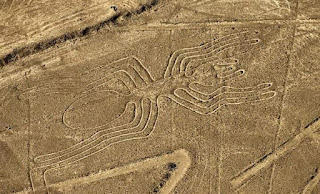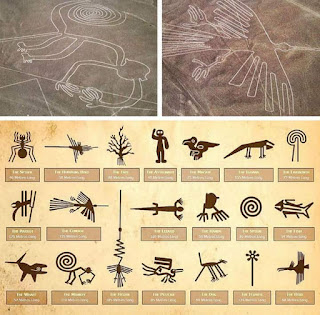The Nazca Lines are a collection of giant geoglyphs—designs or motifs etched into the ground—located in the Peruvian coastal plain about 250 miles (400 kilometers) south of Lima, Peru.
The Nazca Lines are a collection of giant geoglyphs—designs or motifs etched into the ground—located in the Peruvian coastal plain about 250 miles (400 kilometers) south of Lima, Peru.
Created by the ancient Nazca culture in South America, and depicting various plants, animals, and shapes, the 2,000-year-old Nazca Lines can only be fully appreciated when viewed from the air given their massive size. Despite being studied for over 80 years, the geoglyphs—which were designated a UNESCO World Heritage Site in 1994—are still a mystery to researchers.
What Are the Nazca Lines?
There are three basic types of Nazca Lines: straight lines, geometric designs and pictorial representations.
There are more than 800 straight lines on the coastal plain, some of which are 30 miles (48 km) long. Additionally, there are over 300 geometric designs, which include basic shapes such as triangles, rectangles, and trapezoids, as well as spirals, arrows, zig-zags and wavy lines.
The Nazca Lines are perhaps best known for the representations of about 70 animals and plants, some of which measure up to 1,200 feet (370 meters) long. Examples include a spider, hummingbird, cactus plant, monkey, whale, llama, duck, flower, tree, lizard and dog.
The Nazca people also created other forms, such as a humanoid figure (nicknamed “The Astronaut”), hands and some unidentifiable depictions.
In 2011, a Japanese team discovered a new geoglyph that appears to represent a scene of decapitation, which, at about 4.2 meters long and 3.1 meters wide, is far smaller than other Nazca figures and not easily seen from aerial surveys. The Nazca people were known to collect “trophy heads,” and research in 2009 revealed that the majority of trophy skulls came from the same populations as the people they were buried with (rather than outside cultures).
In 2016, the same team found another geoglyph, this time one that depicts a 98-foot-long (30-meter-long) mythical creature that has many legs and spotted markings, and is sticking out its tongue.
And in 2018, Peruvian archaeologists announced they had discovered more than 50 new geoglyphs in the region, using drone technology to map the landmarks in unprecedented detail.
How the Nazca Lines Were Created
Anthropologists believe the Nazca culture, which began around 100 B.C. and flourished from A.D. 1 to 700, created the majority of the Nazca Lines. The Chavin and Paracas cultures, which predate the Nazca, may have also created some of the geoglyphs.
The Nazca Lines are located in the desert plains of the Rio Grande de Nasca river basin, an archaeological site that spans more than 75,000 hectares and is one of the driest places on Earth.
The desert floor is covered in a layer of iron oxide-coated pebbles of a deep rust color. The ancient peoples created their designs by removing the top 12 to 15 inches of rock, revealing the lighter-colored sand below. They likely began with small-scale models and carefully increased the models’ proportions to create the large designs.
Most of the known geoglyphs were formed by removing rocks from only the border of the figures (creating a kind of outline), while others were formed by removing rocks from the interior.
Given the low amount of rain, wind and erosion in the desert, the geoglyphs have remained largely unscathed throughout the centuries.
Nazca Lines and Aliens?
Toribio Mejia Xesspe, a Peruvian archaeologist, began a systematic study of the lines in 1926, but the geoglyphs only gained widespread attention when pilots flew over them in the 1930s. Experts have debated the purpose of the Nazca Lines since then.
In the late 1930s and early 1940s, American historian Paul Kosok studied the geoglyphs from the ground and air. Based on the relative position of one of the lines he studied to the sun around the winter solstice, he concluded that the geoglyphs had an astronomy-related purpose.
Soon after, María Reiche, a German archaeologist and translator, also concluded that the designs had an astronomical and calendrical purpose. She further believed that some of the animal geoglyphs were representative of groups of stars in the sky.
In the late 1960s and early 1970s, however, other researchers, including American astronomer Gerald Hawkins, examined the Nazca Lines and disagreed with the astronomical explanation for the geoglyphs. They also poked holes in other far-out explanations, such as those relating to aliens or ancient astronauts.
Purpose of the Nazca Lines
More recent research suggested that the Nazca Lines’ purpose was related to water, a valuable commodity in the arid lands of the Peruvian coastal plain. The geoglyphs weren’t used as an irrigation system or a guide to find water, but rather as part of a ritual to the gods—an effort to bring much-needed rain.
Some scholars point to the animal depictions—some of which are symbols for rain, water or fertility and have been found at other ancient Peruvian sites and on pottery—as evidence of this theory.
In 2015, researchers presenting at the 80th annual meeting of the Society for American Archeology argued that the purpose of the Nazca Lines changed over time. Initially, pilgrims heading to Peruvian temple complexes used the geoglyphs as ritual processional routes. Later groups, as part of a religious rite, smashed ceramic pots on the ground at the point of intersection between lines.



































Comments
Post a Comment